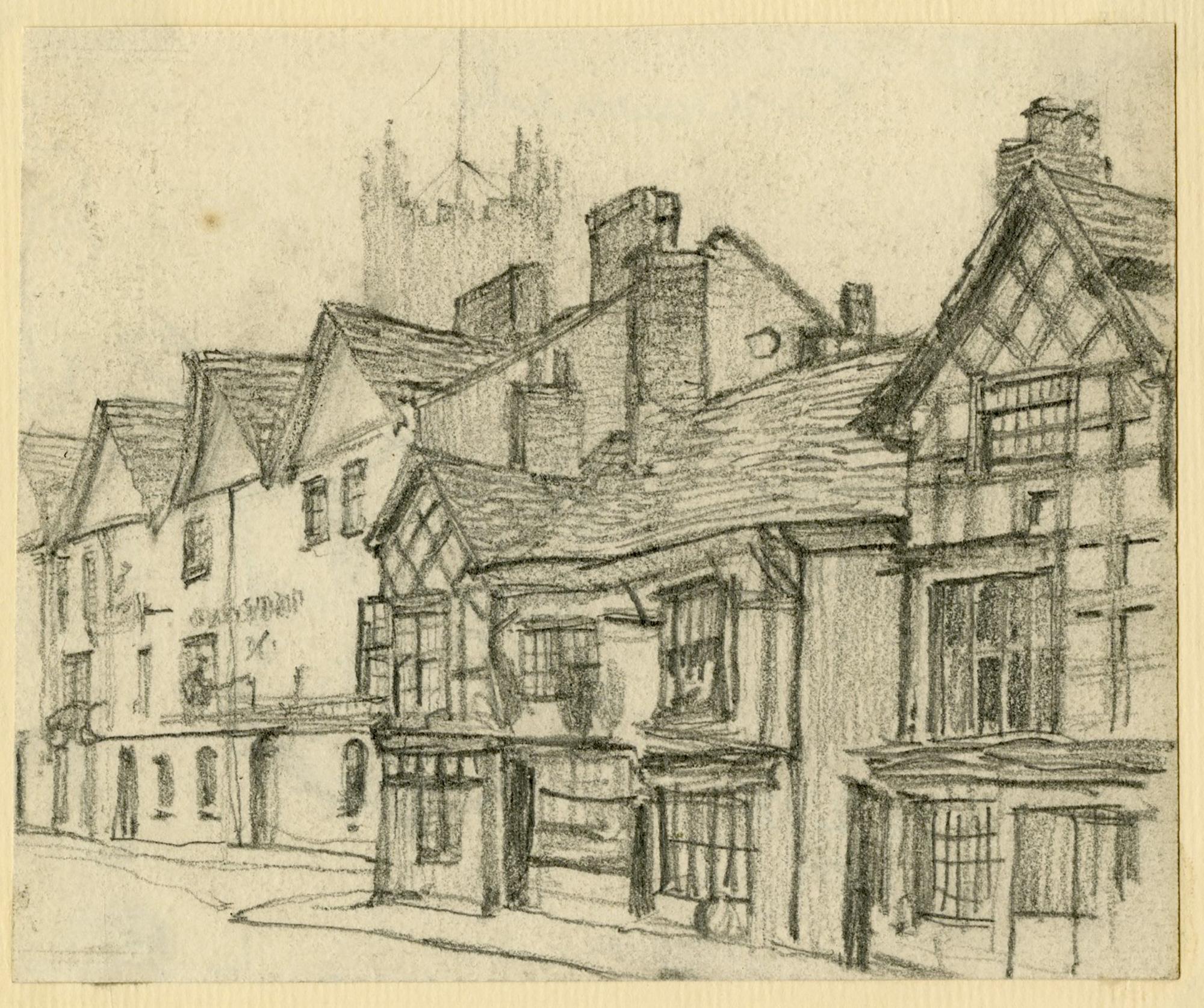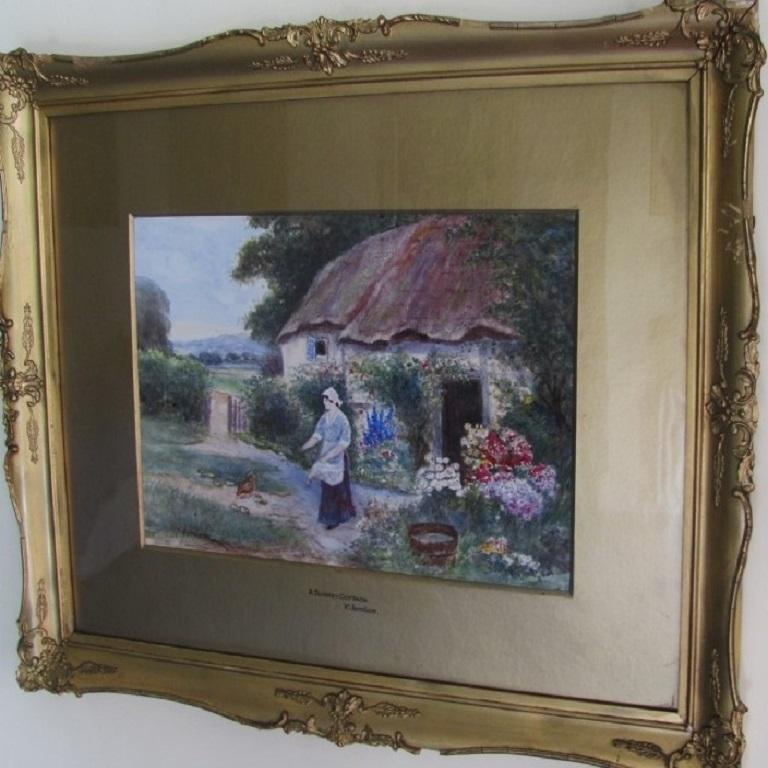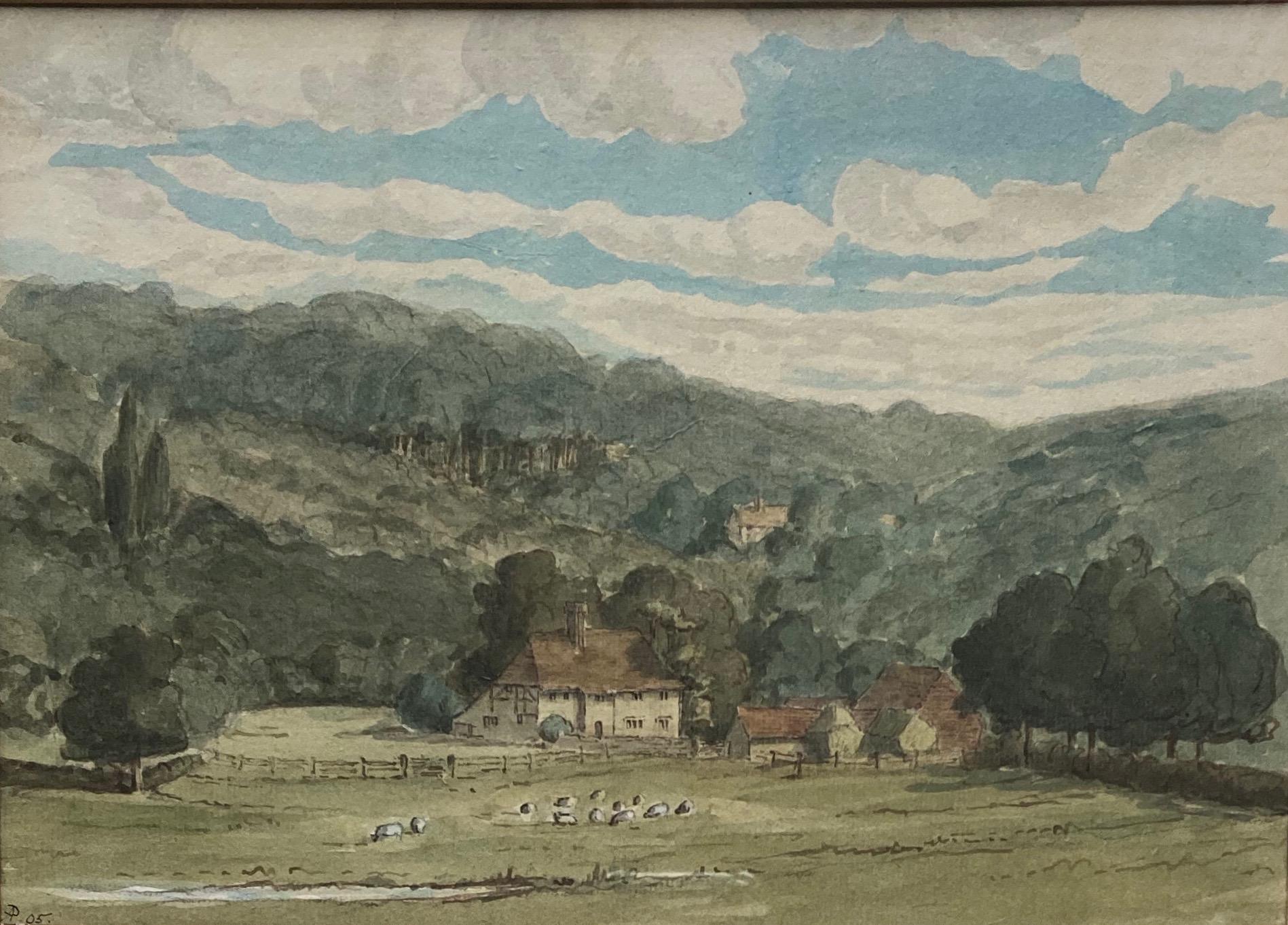Items Similar to Looking toward Nervi, near Genoa, 1903, by British artist Sir George Claussen RA
Want more images or videos?
Request additional images or videos from the seller
1 of 7
Sir George Claussen RALooking toward Nervi, near Genoa, 1903, by British artist Sir George Claussen RA1903
1903
About the Item
A captivating and intimate landscape sketch, gazing towards the charming town of Nervi, near the picturesque city of Genoa. This work was most likely crafted en plein air by the esteemed Sir George Clausen. The skillful strokes and delicate details capture the beauty of the small landscape, inviting viewers to immerse themselves in its tranquility and natural splendor.
The details of the work are as follows:
Sir George Claussen RA (British, 1852 – 1944)
Looking toward Nervi, near Genoa, 1903
signed ‘G CLAUSSEN’ (lower right)
coloured chalk and wax crayon
6 x 8.3/4 in. (15.3 x 22.3 cm.)
Provenance: Chris Beetles, London; Abbott and Holder, London
George Clausen absorbed a range of Continental influences to become a significant plein-air artist of scenes of rural life in oil, watercolour and pastel. The striking, sometime stark naturalism that he learned from Bastien-Lepage and Millet gave way to a light-filled, atmospheric Impressionism. While promoting new developments in painting as a leading member of the New English Art Club, he was eventually accepted by more established societies of artists, including the Royal Academy, becoming a notable Professor of Painting at the Royal Academy Schools. In addition to his distinctive landscapes – both with and without figures – he essayed portraits, nudes, interiors and still life compositions, and produced occasional, but significant murals, one of which was recognised with a knighthood.
George Clausen was born at 8 William Street, Regent’s Park, London, on 18 April 1852, the second of five children of the Danish decorative painter, Jurgen (George) Johnson Clausen, and his wife, Elizabeth (née Fillan).
On leaving St Mark’s School, King’s Road, Chelsea, in 1867, Clausen became an apprentice in the drawing office of Messrs 176 Trollope & Sons, a leading firm of decorators. While there, he also took drawing lessons with John Leghorn, which prepared him for a course of evening classes, on a two-year scholarship, at the National Art Training School, South Kensington. During his time there, he won two of its gold medals for design (in 1868 and 1870). By 1871, he had moved with his family to 9 Stafford Terrace, Fulham Road.
As the result of a commission to decorate the house of the history painter, Edwin Long, Clausen became the artist’s researcher, and received assistance from him in his development as an artist. Taking Long’s advice, Clausen visited Belgium and Holland during the years 1875-76. He studied briefly at the Royal Academy of Fine Arts in Antwerp under Joseph Van Lerius and, absorbing the influence of painters of the Hague School, began to take an interest in working en plein air. The results included High Mass at a Fishing Village on the Zuider Zee (Nottingham Castle Museum), which he showed successfully as his first exhibit at the Royal Academy of Arts in 1876. In the same year, he was elected an associate of the Royal Institute of Painters in Water Colours (becoming a full member in 1879).
Believing that he could learn more from a formal art education, Clausen went to Paris in 1876, in the hope of entering the atelier of Jean-Léon Gérôme, but found it closed. He then considered working under Carolus-Duran, only to be shocked by ‘sloppy paint and bitumen all over the place’, and so returned to London. There he learned not only from the successful genre works of William Quiller Orchardson, Marcus Stone and James Tissot, but also from the experiments of James McNeill Whistler. By the end of the 1870s, he and his family were living at 4 The Mall, Park Road, Haverstock Hill, and he was establishing himself in his own studio.
In 1881, Clausen married fellow artist, Agnes Webster, in Kings Lynn, and they settled first in the village of Childwick Green, near St Albans, Hertfordshire, moving to Grove House, Fag End Road, Cookham Dean, Berkshire, in 1885. They would have three sons and two daughters; Margaret would marry the artist, Thomas Derrick, while Katharine would herself become an artist.
Clausen’s move to the country marked his increasing focus on rural themes, interpreted through a broad technique that involved the use of square-headed brushes. He was influenced in this approach by developments in France, which he visited on painting trips, including that to Brittany in 1882, and for further study, spending a term at the Académie Julian under Bouguereau and Robert-Fleury in 1883 (the year that he was elected to the new Institute of Painters in Oil Colours). He was especially inspired by the example of Jules Bastien-Lepage, whose work he had first seen at the Grosvenor Gallery, and would do much to promote him in England, as exemplified by the article, ‘Bastien-Lepage and Modern Realism’, published in The Scottish Art Review in 1888. He also had his own French success, when he was awarded a silver medal at the Exposition universelle, in Paris, in 1889.
In 1884, critics had attacked the harsh realism of Clausen’s painting, Labourers after Dinner (private collection), when it was shown at the Royal Academy. This encouraged him to help found the New English Art Club in 1886, and he – like his friend and fellow member, Henry La Thangue – would remain a keen advocate of the reform of the Royal Academy after he returned to exhibiting there regularly in 1891. In that year, he and his family moved to Bishops Farm House, Widdington, near Newport, Essex, and many of the local farmyards, barns and fields would feature his work.
Attracted to a range of modern painting, Clausen tempered his monumental depictions of the agricultural labourer, influenced by Jean-François Millet, with an increasingly bright palette, derived from the Impressionists, and an atmospheric use of pastel, inspired by Edgar Degas. However, he strengthened his association with more established institutions, and was elected to the Royal Society of Painters in Water-Colours (ARWS 1889; RWS 1898) and the Royal Academy (ARA 1895; RA 1908). His standing at home was confirmed by a series of solo shows – the first of which was held at the Goupil Gallery, London, in 1902 – while his wider reputation was consolidated through the award of medals at a number of international exhibitions, notably those in Chicago (1893), Brussels (1897) and Paris (1900). He also visited Hungary in 1894 and Italy in both 1898 and 1903.
Having taught at the Royal Academy Schools since the mid 1890s, Clausen became its Professor of Painting during the years 1903-6 (and would become temporary Director and Master of the Painting School in 1926-27). This academic position gave him the opportunity to urge the traditional study of the Old Masters in lectures that were published as Six Lectures on Painting (1904) and Aims and Ideals in Art (1906). From 1905, he maintained a London home and studio at 61 Carlton Hill, St John’s Wood. In 1909, he was master of the Art Workers’ Guild.
Clausen’s own work, exhibited in solo shows at the Leicester Galleries (1909 and 1912), demonstrated how tradition and innovation could complement each other, and it seemed no contradiction for an exponent of Impressionism to undertake public commissions. He was an original member of the Faculty of Painting for the British School at Rome (1912), an official war artist during the First World War (assigned to Woolwich Arsenal) and later a mural decorator of, especially, St Stephen’s Hall, Westminster (1927). The last of those projects led to his being knighted (1927) in a period in which he continued to be elected to exhibiting societies. He became an honorary member of the Royal Society of British Artists (1923) and a member of the Royal Scottish Society of Painters in Water-Colours (1926). Retrospectives of his work were held at Barbizon House in 1928 and 1933. In these later years, he painted numerous landscapes around the Essex village of Duton Hill, where, from 1917, he maintained ‘Hillside’ cottage. Following the outbreak of the Second World War, he and Lady Clausen left their London home to live with their daughter, Margaret, and her husband, Thomas Derrick, at St Finians Farm, Cold Ash, Thatcham near Newbury, Berkshire. He died there on 22 November 1944, eight months after his wife.
His work is represented in the collections of the Royal Academy of Arts and numerous public collections, including the British Museum, Tate and the V&A; Birmingham Museums Trust, Bristol Museum & Art Gallery, Holburne Museum (Bath), Laing Art Gallery (Newcastle upon Tyne), Leeds Museums and Galleries (including both Leeds Art Gallery and Lotherton Hall), Manchester Art Gallery, the Usher Gallery (Lincoln) and the Walker Art Gallery (Liverpool); and National Museum Wales (Cardiff).
- Creator:Sir George Claussen RA (1852 - 1944, British)
- Creation Year:1903
- Dimensions:Height: 6 in (15.24 cm)Width: 8.75 in (22.23 cm)Depth: 1 in (2.54 cm)
- Medium:
- Movement & Style:
- Period:
- Condition:In good condition, float mounted with further mount in cream with washlines, behind glass in a giltwood frame with some scratches and scuffs.
- Gallery Location:Petworth, GB
- Reference Number:1stDibs: LU540312724442
About the Seller
4.9
Platinum Seller
These expertly vetted sellers are 1stDibs' most experienced sellers and are rated highest by our customers.
Established in 2010
1stDibs seller since 2017
226 sales on 1stDibs
Typical response time: 2 hours
- ShippingRetrieving quote...Ships From: Petworth, United Kingdom
- Return PolicyA return for this item may be initiated within 10 days of delivery.
More From This SellerView All
- William Heath Robinson East Coast sea sketch, 1930By William Heath RobinsonLocated in Petworth, West SussexWilliam Heath Robinson (British, 1872-1944) East coast sea sketch, circa 1930 Pencil and watercolour 8.1/2 x 12.3/4 in. (21.7 x 32.3 cm.) There is an extensive passage regarding the ...Category
20th Century English School Landscape Drawings and Watercolors
MaterialsWatercolor, Pencil
- British, 1922, gouache landscape by Sir William RothensteinBy Sir William RothensteinLocated in Petworth, West SussexSir William Rothenstein (British, 1872-1945) Mountain landscape Signed and dated `W. Rothenstein 22’ (lower right) Gouache 20.3/8 x 15 in. (51.8 x 38 cm.) Provenance: Christie’s London, Modern British Paintings, 31 October 1996, lot 2 The English portrait artist Sir William Rothenstein was born January 29, 1872, near Bradford, Yorkshire. William Rothenstein was the son of Moritz Rothenstein, who came to England from Hanover in 1859, and the brother of Charles Lambert Rutherston, the collector, and Albert Daniel Rutherston, the artist. William Rothenstein studied for one year at the Slade School in London under Alphonse Legros, after which he spent four years in Paris, where he attended the Académie Julian. While in Paris, Rothenstein met many of the important artists of the time; he was particularly influenced by James Whistler, Edgar Degas, and Henri Fantin-Latour. After his return to England in 1893, Rothenstein was commissioned by John Lane...Category
20th Century English School Landscape Drawings and Watercolors
MaterialsPaper, Gouache
- St. Ives school, British 20th Century, Fishing boats leaving St Ives harbourLocated in Petworth, West SussexAnne Harriet Sefton Fish (British, 1890-1965) Fishing boats leaving St Ives harbour Pencil and watercolour 11.1/2 x 15.1/2 in. (29.3 x 39.4 cm.) Provenance: Digey Studio, St. Ives Th...Category
20th Century English School Landscape Drawings and Watercolors
MaterialsWatercolor, Pencil
- 19th Century watercolour of fishing boats at low tide by British artist de WintBy Peter de WintLocated in Petworth, West SussexPeter de Wint (British, 1784 – 1849) Fishing boats at low tide Pencil on watercolour 10.3/4 x 16.3/8 in. (27.3 x 41.7 cm.) Peter de Wint was born in Stone in Staffordshire, the son ...Category
19th Century English School Landscape Drawings and Watercolors
MaterialsWatercolor, Pencil
- The Woodland Stream by British artist Charles Frederick Tunnicliffe, 1980By Charles Frederick TunnicliffeLocated in Petworth, West SussexCharles Frederick Tunnicliffe (British, 1901-1979) The Woodland Stream Bears studio stamp `1980’387/24’ (under mount) Pencil and coloured chalks 10.1/2 x 15 in. (26.7 x 38 cm.)Category
20th Century Landscape Drawings and Watercolors
MaterialsPastel, Chalk
- Post Impressionist French landscape in blues and reds, pastelsLocated in Petworth, West SussexAndre Bicat (French, 1909 – 1996) A Post Impressionist landscape Pastel on paper Signed ‘Bicat’ (lower left) 15.3/8 x 24 in. (39 x 61cm.)Category
20th Century Post-Impressionist Landscape Drawings and Watercolors
MaterialsPaper, Pastel
You May Also Like
- The Shambles, York, with Yorkminster in the backgroundLocated in Middletown, NYBlack crayon on white wove paper, 4 3/8 x 5 3/8 (110 x 135 mm), signed in pencil on the verso. Adhered to an archival laid-paper mount at each of the four corners on the verso. With ...Category
Late 19th Century English School Landscape Drawings and Watercolors
MaterialsCrayon, Handmade Paper
- 19th Century Surrey Country Cottage Watercolour V JordanLocated in York, GBV JORDAN (19th Century) , A Surrey Cottage watercolour heightened with white, signed, inscribed mounts, size overall 23 x 19 inches approx. painti...Category
19th Century English School Landscape Drawings and Watercolors
MaterialsWatercolor
- 19th Century Warwickshire Country Cottage Watercolour V JordanLocated in York, GBV JORDAN (19th Century) A Warwickshire Cottage, watercolour heightened with white, signed, inscribed mounts, size overall 23 x 19 inches approx. painting 9 1/2" x 13 1/2", The waterc...Category
19th Century English School Landscape Drawings and Watercolors
MaterialsWatercolor
- River Teign DevonLocated in Sydney, NSWArtist: T. Leslie (British) Title: River Teign, Devon (Circa 1870s) Medium: Watercolour Condition: The painting is in good condition Provenance: Private Collection Sydney About: ...Category
1870s English School Landscape Drawings and Watercolors
MaterialsWatercolor
- View over Buckingham Palace Garden, Big Ben and Westminster PalaceLocated in Stockholm, SEA fine watercolor by an unknown English artist with a view overlooking the Buckingham Palace garden and its lake, towards the West facade of the Buckingham Palace. In the distance on...Category
Late 19th Century English School Landscape Drawings and Watercolors
MaterialsPaper, Watercolor
- Circle of Thomas Girtin, Sheep in a hilly pasture, early English watercolourLocated in Harkstead, GBA charming rural scene painted in the style of Thomas Girtin with good strong colours. Circle of Thomas Girtin Sheep in a hilly pasture with a farmhouse Signed with initials and dated "AP (18)05' Watercolour, with attractive washline mount 6¾ x 9¾ inches with frame 14 x 17 inches including frame Thomas Girtin was born in London in 1775, the same year as J.M.W. Turner, and died in 1802, at the age of twenty-seven. The art of watercolour was transformed during Girtin's brief life. This was especially marked in landscape watercolours, which grew in scale and ambition. Led by Girtin and Turner, watercolourists abandoned careful stained drawings for a more dramatic style of painting that captured moods and a range of light and weather effects. Not everyone welcomed the rapid technical changes, especially as revolution and war threatened the established political order. For a brief period, however, watercolour painting was the epitome of modern art, and the landscapes of Girtin and Turner were welcomed as a national triumph. Girtin was apprenticed at the age of 14, in the year of the French Revolution, and by the age of 19 he was exhibiting at London's Royal Academy, and producing watercolour landscapes for private patrons. However, unlike Turner, Girtin remained something of an outsider to the art establishment: he did not study at the Academy's schools, and was rumoured to have radical, or even revolutionary sympathies. He also tried to break away from the traditional reliance on the patronage of the wealthy, partly by trying to sell his work on the open market, and partly through two larger projects aimed at a mass audience: a group of twenty printed Views of Paris and an enormous 360 degree panorama of London...Category
Early 19th Century English School Figurative Drawings and Watercolors
MaterialsPaper, Watercolor
Recently Viewed
View AllMore Ways To Browse
Newport By
Old Village Streets
How To Do A Review
French Old Master Drawing
Duran Light
White Duck Swimming
Arthur Mathews
Calvert School
Framed Lithograph Bookkeeper
Japanese Barometer
Retro Bathing Caps
Retro Scifi Art
River In Alps Oil On Canvas
Allen Holt
Sally Taylor
Calder Maquette
Map Of Charleston
Peter Rice Jones





